
* In the mid-1950s, the Soviet Union began work on a four-engine turboprop airliner, which emerged at the end of the decade as the Ilyushin "Il-18". It proved extremely successful in both commercial and military service, with the Soviet military operating specialized variants, in particular the "Il-38" sub hunter platform. This document provides a history and description of the Il-18 family.
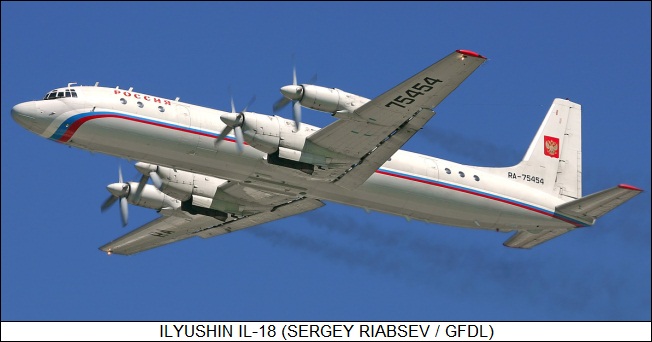
* Before World War II, the USSR had acquired a modern airliner in the form of the "Lisunov Li-2", a license-built variant of the famed US Douglas DC-3. Many Li-2s were built, with the type performing considerable service in the war, and after the war the Li-2s became an important element of Soviet civil aviation. They were complemented in service by the new "Il-12" twin-engine piston airliner, which was followed in turn by an improved derivative, the "Il-14" -- both products of the OKB (experimental design bureau) run by Sergey Vladimirovitch Ilyushin. Ilyushin also built a prototype of a four-engine piston transport, designated the "Il-18", with some resemblance to the Boeing Stratocruiser, but it was judged too large for the level of passenger traffic in the 1940s and was not produced.
Civil aviation wasn't all that important an element of Soviet society in the immediate postwar period, largely due to the fact that the mobility of much of the populace was restricted by an internal passport system, and when they traveled, it was usually by train anyway. It wasn't until the death of Soviet dictator Josef Stalin in 1953 that the passport system was abandoned. That implied increased usage of airliners, as did the government's interest in ramping up exploitation of the distant regions of Siberia -- train travel being uncomfortably slow over the vast distances involved.
More demand for airliners meant new airliners, leading to the development of the Tupolev Tu-104 "Camel" twinjet airliner -- derived from the Tu-16 "Badger" bomber -- as well as the Tu-114 "Cleat" long-range four-engine turboprop airliner -- derived from the well-known Tu-95 "Bear" bomber. The Tu-104 had fairly modest range and the Tu-114 was on the large side, so a niche remained for a smaller turboprop airliner with good range. At the end of 1955, the Soviet authorities passed down a directive for the Kuznetzov and Ivchenko engine OKBs to develop competing powerplants, with the Antonov and Ilyushin OKBs to design four-engine airliners that could use either engine.
The Antonov machine would emerge as the "An-10", ancestor of the well-known "An-12" cargolifter, both discussed elsewhere and not mentioned further here. The Ilyushin airliner was given the designation of "Il-18", recycling the designation of the four-engine piston Il-18 of a decade earlier -- it hadn't been put into production, and so the Il-18 designation was free for re-use.
The two turboprop engine contenders for the Il-18 powerplant materialized as the Kuznetsov "NK-4", where "NK" stood for "Nikolai Kuznetsov", and the Ivchenko "TD-20", where "TD" stood for "turbovintovoy dvigatel (turboprop engine)" -- though the TD-20 was soon redesignated the "AI-20", with the "AI" standing for "Aleksandr Ivchenko". Ilyushin preferred the NK-4, it appears mostly for political reasons, but though both engines entered production, the NK-4 was canceled after manufacture of only 200 units. It appears that the cancellation of the NK-4 was also a political matter: several Soviet engine designers thought it was the superior engine, having better specific fuel consumption (SFC) and lighter weight than the AI-20, but it made no difference, the AI-20 being selected as the winner.
* As far as Il-18 itself went, the Ilyushin OKB had been considering possible configurations for a four-turboprop airliner from 1954. Following the formal go-ahead for development, the general configuration of the new airliner took shape, following the general configuration established by the Douglas DC-4 a decade earlier: an all-metal low-wing four-engine monoplane with conventional flight surfaces, tricycle landing gear, and cabin pressurization. Full-scale development was authorized in late August 1956, with work beginning on a prototype.
The prototype was rolled out in June 1957, performing its maiden flight on 4 July 1957 from the factory airfield at Khodynka, near Moscow. The crew was led by Vladimir Konstantinovich Kokkinaki, the Ilyushin OKB's well-known chief test pilot. The aircraft performed generally as designed, with the usual sorts of bugs to be worked out but no serious "funnies", and in fact it was flown on a brief hop to the Moscow airfield to be displayed to government officials on 10 July, alongside the new An-10 and Tu-114. Only ten days later, on 20 July the Il-18 prototype performed a fly-past for the public and foreign observers at the yearly airshow at Tushino Airport near Moscow. NATO assigned the type the somewhat unflattering reporting name of "Coot". Some sources claim a second prototype was built, but no substantial evidence confirms this.
Production had been authorized even before the prototype got off the ground, with manufacture to take place at a state factory at Khodynka -- confusingly, not the same factory as the factory at the same site that had built the prototype. All Il-18s would be built at this plant. Deliveries of the production "Il-18A" to the state airline Aeroflot began before the end of the year; after evaluation, training, and route-proving, the Il-18A went into operational service in April 1959. As it was being evaluated, the Il-18A was also setting performance records in its class. The Il-18As were more or less for evaluation, with only 20 built; even before formal introduction to Aeroflot service, production had moved on to the "Il-18B".
BACK_TO_TOP* The Il-18B provides a baseline for a description of the Il-18 family. Construction was mostly of aircraft aluminum alloy, with some magnesium and steel assemblies. Particular care was taken in ensuring that the cylindrical fuselage was stressed to tolerate the repeated cyclings of pressurization and depressurization, that issue having proven troublesome with other contemporary airliners -- most notoriously the British de Havilland Comet.
The wings featured three spars in the center section, with twin spars outboard; they had a dihedral of 3 degrees and an angle of incidence of 3 degrees as well. There was a double slotted flap inboard and a two-section aileron outboard on each wing, with the wing / flap arrangement providing good short-field performance. The tail assembly was of conventional configuration, with rudder and elevators. All controls were manual with pushrod connections, except for cable-actuated trim tabs and the electrically driven flaps.
The Il-18B was powered by four Ivchenko AI-20A Series 1 turboprops, each providing a take-off power of 2,985 kW (4,000 SHP) and sustained power of 2,090 kW (2,800 SHP) at cruise altitude. Incidentally, early Il-18A production had initially been fitted with Kuznetsov NK-4 engines, but they were soon swapped out for AI-20s. Later Il-18B production featured AI-20A Series 2 engines, with the same power ratings but technical improvements; older machines were updated with the Series 2 powerplants. The AI-20s drove four-bladed variable-pitch reversible props with a diameter of 4.5 meters (14 feet 9 inches), featuring prominent prop spinners, and hydraulic actuation for prop pitch. The engines were mounted above the wing, featured integrated fire extinguishers. The engines were started with electric motors, the power for the motors being provided by a ground cart. All fuel tanks were in the wings, providing a total fuel capacity of 23,700 liters (6,253 US gallons).
All landing gear assemblies hydraulically retracted forward, automatically deploying if there was a hydraulics system failure; low-pressure tires were used to deal with rough fields. The steerable nose gear had two wheels side-by-side, while each main gear assembly had four wheels in a 2x2 bogie arrangement. The main gear retracted into the inboard engine nacelles, with the bogies hinging to lie flat after being retracted. Along with cockpit "gear down" indicators, there was a mechanical "pop-up" indicator on the nose to show if the nose gear was down -- a common and sensible gimmick on Soviet aircraft. Wheel brakes were hydraulically actuated; a nitrogen gas system provided for braking, as well as feathering the props, in case other systems were lost. There was a bumper under the tail to protect the aircraft from tail strikes.
The Il-18B featured an Emblema weather / navigation radar in the nose, at the time radar being a relatively new item for Soviet commercial aircraft. The radar was fitted in a "grafted-on" nose, which slightly degraded the aircraft's generally clean lines. The radar turned out to be a bit too much of an innovation, since it proved difficult to get it to work properly; most or all Il-18A and Il-18B machines were delivered without radar, in principle to be upgraded with it later.
The Il-18B was also innovative in being equipped for automatic landing approach. Instrumentation was comprehensive, permitting flight at night and in all but the worst weather; it included state-of-the-art radio navigation systems as well as an autopilot. There was a radio antenna running from the cockpit back to the wings over the top of the fuselage, which also cluttered up the aircraft's lines. One interesting item was a flare dispenser for signaling an emergency. The Il-18B featured electrical de-icing for flight surfaces, props, cockpit glazing, pitot heads, and air conditioning heat exchangers; engine intakes were de-iced with hot engine bleed air.
The Il-18B featured five cabin crew, including pilot and copilot; navigator; flight engineer; and radio operator. Typical passenger accommodations were 89 seats in two cabins, with 19 seats in the forward cabin and 70 seats in the rear cabin. Most of the seats were arranged in five rows, except where cabin kit dictated fewer seats. There was a toilet forward of the first cabin; a coat closet on each side, a fire extinguisher rack, and a galley between the cabins; and a rear compartment with a sofa on one side, a coat closet on the other, and two toilets. An alternate configuration provided 80 seats, with 15 forward and 65 to the rear. The Il-18 prototype only had 75 seats. All the passenger seats could be yanked for cargo carriage, but the Il-18B wasn't a practical cargo carrier, since the aircraft didn't have a large cargo door, and it had no cargo handling facilities such as an overhead crane on rails or floor rollers.
There were overhead baggage racks, a fairly new item for Soviet airliners at the time. There were doors on the left side of the aircraft, front and back, that opened inward, sliding to the side, plus twin emergency exits on each side over the wings. As mentioned, the aircraft was pressurized, by engine bleed air, as well as climate-conditioned; a ground cart could be used for air conditioning while the aircraft was parked. There were 15 round double-paned windows on the left side of the fuselage and 17 on the right side, reduced to 14 and 16 in later production; the prototype had 15 windows on each side.
There were three baggage compartments, all with doors on the right side of the aircraft: two low on the fuselage with doors that opened in and up -- one forward and one rear of the wing -- plus a compartment in the tail, with a bigger upward-hinged door. Experience demonstrated the doors were too small, but they were never enlarged.
BACK_TO_TOP* Following the single prototype and the 20 Il-18A airliners, a total of 65 Il-18B airliners was built. At least three Il-18B machines were completed as "Il-18S" VIP transports -- the "S" stood for "Salon", a normal Soviet name for a VIP machine.
* The Il-18B was followed in production by the "Il-18V" -- "V" being the next letter in the sequence of the Cyrillic alphabet. The primary change was a wholesale reorganization of the passenger accommodations, with three passenger compartments instead of two. The passenger doors were moved towards the wing, framing the center passenger compartment, with the entry vestibules separating the compartments. Passengers entering the front door went left to the front compartment, right to the center compartment, while passengers entering the rear door went right to the front compartment, left to the rear compartment.
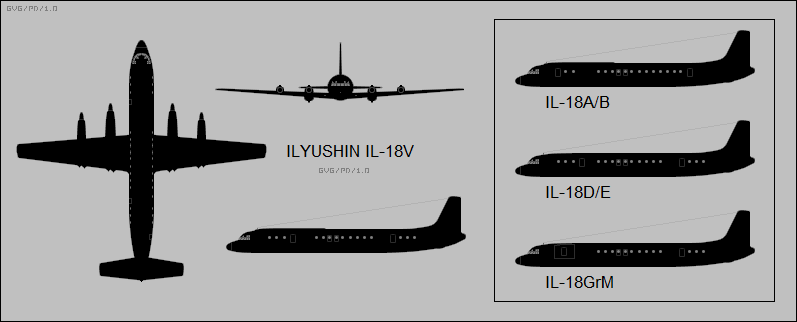
The galley was improved and relocated to behind the rear compartment. Flight attendants were happy with the change since its original position had been inline with the props, meaning it was the noisiest place in the airplane. The galley shared the rear with a lavatory. Two lavatories were sited in the location vacated by the galley, accompanied by coat closets; the position of the lavatories proved handy in that nobody wanted to linger in them for any longer than necessary, being driven out by the drone of the props. The window arrangement was rearranged along with the shuffling of the doors, resulting in 15 windows on the left and 16 on the right -- one window being added to provide light in the galley.
Initially, the Il-18V was to carry 78 passengers, with 20, 50, and 8 passengers in the forward, center, and rear cabins respectively. The forward and center cabins had tourist-class accommodations, while the rear cabin provided first class accommodations, with reclining "sleeperette" seats. The first-class accommodations turned out to be a bad idea, one problem being the fact that the Soviet system was in principle opposed to class distinctions. That wasn't just an abstract issue either, since Aeroflot sold airline tickets on a standard fare with no consideration of flight class. From a "business" point of view, first class didn't make any sense.
A second problem was the fact that the Soviets, while often very competent at production of military and industrial technology, were just as often inept in the production of goods for consumer comfort -- and the sleeperette seats were badly designed to the point of hazardous, so shoddily put together they were usually broken anyway. Thanks to inertia, the sleeperettes were retained for some time, until accommodations were finally changed to an all-tourist configuration.
The simplest arrangement was just to put 14 seats in the rear compartment, giving accommodations of 20 + 50 + 14 = 84 seats; however, the preferred solution was to cram another row of seats into the center section, giving accommodations of 20 + 55 + 14 = 89 seats. The rear section was still preferred, since the noise levels were lowest. Later on in the Il-18V's life, a higher-density seat arrangement was implemented, with 110 seats. It was very uncomfortable; ironically, the Soviet system ended up imitating the mercenary practices of capitalist budget airlines, even though the USSR wasn't supposed to be based on the profit motive.
At least 24 Il-18V airliners were completed as VIP / Salon transports. They were available in various configurations, with from 35 to 50 seats, plus various luxuries such as armchairs, sofas, tables, and beds.
___________________________________________________________________
ILYUSHIN IL-18V "COOT":
___________________________________________________________________
wingspan:
37.4 meters (122 feet 8 inches)
wing area:
140 sq_meters (1,505 sq_feet)
length:
35.9 meters (117 feet 9 inches)
height:
10.165 meters (33 feet 4 inches)
empty weight:
31,500 kilograms (69,440 pounds)
MTO weight:
61,200 kilograms (134,920 pounds)
max speed at altitude:
650 KPH (405 MPH / 350 KT)
service ceiling:
12,500 meters (41,000 feet)
range, max payload:
3,000 kilometers (1,860 MI / 1,620 NMI)
___________________________________________________________________
* The Il-18V was refined in production and in service, one of the most significant being fit of a TG-16 auxiliary power unit (APU) turbine engine in the tail section, with the exhaust port on the right side of the tail; there was no intake port, the APU obtaining its airflow from inside the rear compartment. The APU provided ground power and engine starting power. Earlier Il-18 variants were also refitted with the APU.
An APU installation had originally been tested in a one-off prototype, the "Il-18I", which was built to check out various design improvements; the "I" stood for "issledovatelskiy (research)". However, the Il-18I's APU wasn't installed in the tail, instead being fitted in a belly fairing forward of the wings that popped down when the APU was in operation. The Il-18I also sacrificed the rear baggage compartment to permit fit of more seats, though that scheme wasn't adopted for service.
Another later Il-18V production feature was a set of anti-collision lights, which were similarly refitted to earlier machines. This innovation was actually at the direct command of Soviet Premier Nikita Khrushchev, who paid a state visit to the USA in 1959, noticed the use of anti-collision lights on Western airliners -- and thought they were such a good idea that, on coming back home, he issued a directive that they be implemented on Soviet airliners.
Of course, avionics were upgraded as new technology became available. Unlike the Il-18B, the Il-18V was delivered with Emblema radar installed, though it was notoriously unreliable for some time. It turned out that the radar electronics didn't cope well with being installed in the unpressurized nose; the electronics were relocated into the pressurized fuselage, and the radar worked much better. The electric de-icing system also didn't work very well until the mid-1960s, when the electric drive scheme was modified, resulting in much more satisfactory operation.
A big problem with early production was the poor reliability of the AI-20 Series 3 engines, which had a time between overhauls (TBO) in the range of 200 to 400 hours. The AI-20 Series 5 (AI-20K) engine variant was finally introduced, with a TBO of 2,000 hours -- unimpressive by modern standards, but a big improvement. One issue that was never addressed was the noise, the high noise levels being a real problem for the passengers. The Ilyushin OKB tinkered with a British de Havilland prop synchronization system to reduce noise and it worked well, but it would have been too expensive to retrofit the Il-18 fleet with it, and so it wasn't done.
BACK_TO_TOP* Another one of the desireables for the Il-18 was greater range. One Il-18V was modified to a long-range configuration for servicing Soviet Antarctic research stations, with this machine fitted with more fuel tanks -- where they were installed is unclear -- plus bigger oil tanks, resulting in bulges in the engine nacelles; and enhanced avionics, including a star tracker for long-range navigation. This machine was given no special designation. It performed flights to Antarctica in 1961 and 1962, being eventually painted in Aeroflot red-white polar colors to make it easier to spot if it went down on the ice.
That experiment working well, the Ilyushin OKB decided to improve on it, building five "Il-26V-26A" machines for polar missions. They featured a large fuel tank installed in the fuselage between the wings, which had the effect of dividing the passenger compartments into forward and aft sections -- of course, the front compartment being only accessible through the front passenger door and the rear compartment only accessible through the rear passenger door. They were also given bigger oil tanks and improved avionics; presumably they were, sooner or later, given red-white polar paintjobs. The Il-26V-26A went into service in 1963.
The designation "Il-18D" -- where "D" stood for "dalniy (range)" -- has been associated with the Il-26V-26A, but that designation was more definitely assigned to the next main production version of the Il-18 to follow the Il-18V. The basis for the Il-18D was the AI-20 Series 6 AKA AI-20M turboprop engine, which was a significant improvement over earlier engine variants in all respects. The AI-20M raised take-off power from 2,985 kW (4,000 SHP) to 3,610 kW (4,250 SHP), improving take-off performance under "hot and high" conditions and permitting higher take-off weights. Higher continuous power ratings also made for more efficient cruise, while the AI-20M had good reliability, was lighter, and in particular featured much improved SFC.
The improved fuel economy meant greater range, but the production Il-18D also had increased fuel tankage, more discreetly added than in the polar mission variants, using a wing center section tank that didn't split the passenger cabin. The center tank had a capacity of 6,300 liters (1,662 US gallons), increasing total fuel capacity to 30,000 liters (7,915 US gallons). The passenger cabin was also modified, resulting in an altered window pattern -- 17 windows to left, 16 to right. The Il-18D eliminated the antenna running over the top of the forward fuselage.
Two Il-18D prototypes were built, with the first entering flight test in the summer of 1964. Development of the AI-20M engine actually lagged behind development of the Il-18D airframe, and so an interim version, the "Il-18E", was produced, with the new airframe but the old AI-20K engines; 23 were produced. The Il-18D went into production in the summer of 1966, with 122 built up to end of production in 1969, ending manufacture of the civilian variants of the Il-18 family. A number of Il-18D / Il-18E Salon VIP transports were produced, featuring luxury accommodations.
* As mentioned, the Il-18 could in principle be used as a cargo transport by yanking the seats and other conveniences, but lacking any cargo-handling facilities, it was far from optimum for the role, and it seems "stock" Il-18s were rarely if ever used as cargolifters. However, a number of Il-18 machines -- from the Il-18A on -- were fitted out as cargolifters for the Red Air Force, with passenger accommodations stripped out; the floor was reinforced and an overhead rail with an electric hoist was installed. No matter what civil airliner variant they were derived from, they were all ultimately designated "Il-18T".
The machines didn't have a proper cargo door, limiting the size of cargoes they could carry; special pallets were built for them, and they also had a fold-up cargo-loading conveyor that could be deployed outside of the aircraft to get cargoes to the door, the conveyor being stowed in the forward baggage compartment when not in use. Apparently the Il-18Ts could also be configured as troop transports, with 114 seats in three rows; or as medical evacuation aircraft, with 63 stretchers and medical attendant. It is unclear if these alternate configurations were ever used in service.
From the late 1970s, a number of civil Il-18s were converted to a cargolifter configuration much like the Il-18T, the machines being designated "Il-18Gr" -- the "Gr" standing for "gruzovoy / cargo". A decade later, the Ilyushin OKB got around to implementing a better cargolift modification, featuring an upward-opening hydraulically-actuated large cargo door on the forward left fuselage, with dimensions of 3.5 x 1.825 meters (11 feet 6 inches x 6 feet). The forward passenger door was embedded in the cargo door; the door assembly was pressure-sealed. Some thought had been given to putting the entire front section of the aircraft on hinges so it could be swung to the side for cargo-loading, but that scheme was judged as too ambitious.
The variant was designated "Il-18GrM", with a number of machines converted to this configuration from the early 1990s. Sources also mention "Il-18 Combi" modifications, with passengers carried in the rear section and cargo in the forward section; details are scarce, but presumably they had the cargo modifications of the Il-18Gr, though not the big cargo door.
Along with the military Il-18T cargolifters, in 1968 a single Il-18D was converted into a military paratroop transport, the "Il-18TD", with tip-up seats along the walls of the fuselage and an overhead cable for hooking up parachute static lines. It wasn't particularly useful for dropping cargoes, so it wasn't introduced to service. The Red Air Force operated some Il-18 VIP / Salon machines, and a number of Il-18s were converted into various staff transport / command post configurations, a matter discussed in more detail below.
* Plans were floated for license production of the Il-18 by the Avia organization in Czechoslovakia, with Avia engineers actually coming up with a paper design for a cut-down Il-18 with twin AI-20 turboprops. Avia production never actually happened; all production Il-18s were built at Khodynka.
Aircrews definitely liked the Il-18, since it had good handling and was very forgiving, as well as reliable and cheap to fly. Passengers were not so happy with it, because as mentioned it was noisy, and high-density seating arrangements could be uncomfortable. The Il-18, also as noted, proved valuable in support of Soviet Arctic and Antarctic operations, and as discussed below it proved a useful platform for special missions. Aeroflot Il-18s were commonly used in support of military operations, the type providing extensive service during the Afghanistan War in the 1980s, ferrying live troops in and out of the theater, and on occasion hauling dead troops back home in coffins. It was used in humanitarian missions as well, hauling supplies to disaster areas.
The Il-18 was widely exported, with the type obtained by Warsaw Pact nations and Cuba; it was also flown by China, North Korea, and Vietnam, along with more than a dozen African nations. It doesn't appear any are still flying today.
BACK_TO_TOP* Thanks to its ability to carry heavy loads, the Il-18 was easy to adapt to a wide range of uses, and a number of specialized variants were built, or modified from stock aircraft:
The Il-18 was extensively used for systems flight test and trials. Avionics testbeds tended to sport a variety of antenna fairings and "nose jobs". For example, one Il-18A performed trials of the Berkut (Golden Eagle) system radar for the Il-38, discussed below -- with this machine, designated "Il-18SL", being fitted with a radome under the forward fuselage. An Il-18V was modified to test the Obzor-K radar for the Tupolev Tu-160 "Blackjack" bomber, featuring a pointy grafted-on nose; this machine was designated the "SL-18V". Later, the Sl-18V was also fitted with a MAD boom on the tail.
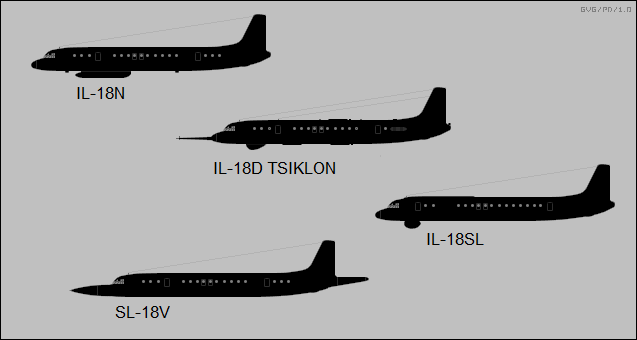
One Il-18A was used for tests of de-icing systems, with a sprayer mounted on top of the forward fuselage and the article to be tested mounted on the back. This machine was designated the "Il-18LL", the "LL" suffix standing for "Letushchaya Laboritoriya (Flying Laboratory)"; it was a common, if not universal, suffix for Soviet trials aircraft. This is only a sampling of the different Il-18 trials configuration, dozens being implemented, often with the same trials machine remodified to various configurations. Some Il-18s were also used for engine trials.
BACK_TO_TOP* The Il-18 served in strictly military roles as well. One of the first and undoubtedly the best-known of the strictly military Il-18 derivatives was the "Il-38" sub-hunter aircraft.
In the late 1950s and the early 1960s, the US Navy was introducing the Polaris ballistic missile submarine force, leading the USSR to seek equalizers. One option was an ocean patrol aircraft, with the Il-18 seen as a good platform for the job and development of the Il-38 sub-hunter beginning in 1960. Initial flight of the first prototype was on 28 September 1961, with Kokkinaki at the controls, supported by two aircrew. The prototype initially lacked operational avionics; it was gradually enhanced to near production standard. Debugging the machine's antisubmarine warfare (ASW) systems proved time-consuming; the first production Il-38 performed its initial flight in 1967, with the type accepted into Soviet Naval Aviation service in 1969. When NATO got wind of the Il-38, it was assigned the reporting name "May".
* The Il-38 leveraged off the basic Il-18 airframe, systems, and engines, being powered by AI-20M turboprops -- though AI-20A engines were used early in the development program due to the non-availability of the AI-20M. The Il-38 featured a fuel tank in the midwing torsion box, like that evaluated on the Il-18I demonstrator machine. Beyond the commonalities, there were also major changes in configuration, the pressure cabin being restricted to the forward cockpit area and a compartment for systems operators behind it; combat systems were stowed in the unpressurized fuselage, with a weapons bay fore and aft of the wings. Due to the change in center of gravity, the wings were moved forward 3 meters (10 feet).
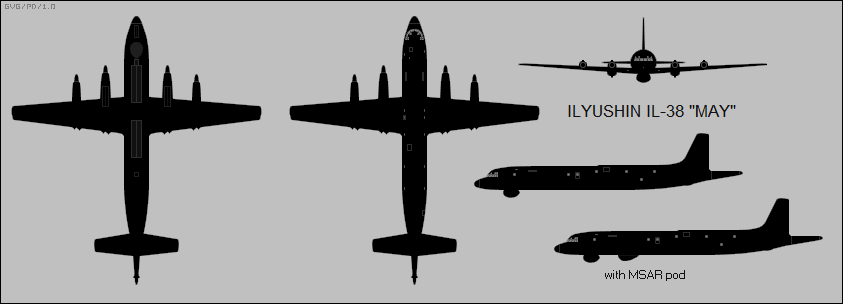
Combat avionics were most visible in a prominent radome for the radar associated with the Berkut search & targeting system (STS) behind the nose gear evaluated on the Il-18SL -- there was no radar in the nose, it seems the Berkut system radar could keep an eye on the weather -- and a MAD boom sticking out behind the tail. The nosewheels featured a mudguard to keep them from kicking up mud and rocks that might damage the radar fairing. The forward weapons bay held sonar buoys, while the rear weapons bay held munitions such as depth charges (nuclear or conventional), mines, or homing torpedoes. The weapons bays were heated, since some of the more sophisticated stores didn't cope well with extreme cold.
The Red Navy had asked the Ilyushin OKB to consider underwing stores such as antishipping missiles, but the reply came back that the wings were too heavily loaded as they were. Unusually, the IL-38 didn't have a tail turret, commonly featured even on transports like the An-12, the conclusion being that it would simply be too heavy. Maximum warload, including sonobuoys, was 8,000 kilograms (17,640 pounds). A fuel tank was fitted above the forward weapons bay, with total fuel capacity running to 33,820 liters (8,925 US gallons).
There was a heat exchanger on each side of the forward fuselage to get rid of heat from the combat systems. The tailfin featured a long extension running up the fuselage to the wings for a communications antenna. An APU -- it appears the TG-16 -- was fitted in the rear fuselage about midway between wings and tail assembly, with an exhaust port on the lower left side of the fuselage.
There were five crew in the forward cockpit -- pilot, copilot, navigator, radio operator, and flight engineer -- plus two in the systems operators compartment -- radar operator and sonobuoy operator, both on backwards-facing seats. Since patrol missions could be protracted, crew accommodations included a galley, a toilet, a table, and a rest area with a folding bunk. The cabin pressurization was backed up by a backup crew oxygen system. One of the puzzles to anyone inspecting drawings or images of the Il-38 is how the crew got in and out, the passenger doors having been deleted: there was actually a belly hatch between the radome and the forward weapons bay, with a hydraulically-activated door at its front that would serve as a windbreak when bailing out. The unpressurized equipment section was accessible from the crew section.
There was an escape hatch for ditching on the top of the cockpit, offset to the left, as well as an Il-18-style emergency exit above the left wing. There was a hatch on top of the aircraft behind the wings, offset to the left, for an inflatable life raft; there were controls inside and outside the aircraft to deploy the raft. Each crewman also had a personal survival kit with a raft. There was a porthole window on each side of the systems operators compartment behind the cockpit, plus a number of small portholes along each side of the fuselage. The original Il-18's rear baggage door was retained, though it was actually used a service door.
Along with the combat avionics -- radar, MAD, sonobuoys and receiver system, plus an "electronic support measures (ESM)" system to characterize and locate radio emitters, all integrated in the Berkut STS through a central processor -- the Il-38 featured radios; identification friend or foe (IFF) transceiver; and an extensive navigation suite, including both radio navaids and a star tracker system, that was also linked into the Berkut STS.
___________________________________________________________________
ILYUSHIN IL-38 "MAY":
___________________________________________________________________
wingspan:
37.4 meters (122 feet 8 inches)
wing area:
140 sq_meters (1,505 sq_feet)
length:
40.1 meters (131 feet 7 inches)
height:
10.1 meters (33 feet 2 inches)
empty weight:
31,500 kilograms (69,440 pounds)
MTO weight:
66,000 kilograms (145,500 pounds)
max speed at altitude:
650 KPH (405 MPH / 350 KT)
service ceiling:
10,000 meters (32,800 feet)
range, max payload:
9,500 kilometers (5,900 MI / 5,130 NMI)
___________________________________________________________________
* Although 250 Il-38s were planned, only 65 machines were built to end of production in 1972, with manufacture performed at the same state factory in Khodynka that built the Il-18. In service, the Il-38 proved popular with crews, both for its good handling and its reliability, the type having an excellent safety record. Five were obtained by the Indian Navy; some Il-38s based in Egypt in the early 1970s were flown in Egyptian markings, but they remained under Soviet control and were flown by Soviet crews. Soviet Il-38s were on occasional operated from friendly states including Libya, Syria, South Yemen, and Ethiopia; two Mays were destroyed by Ethiopian insurgents in 1984.
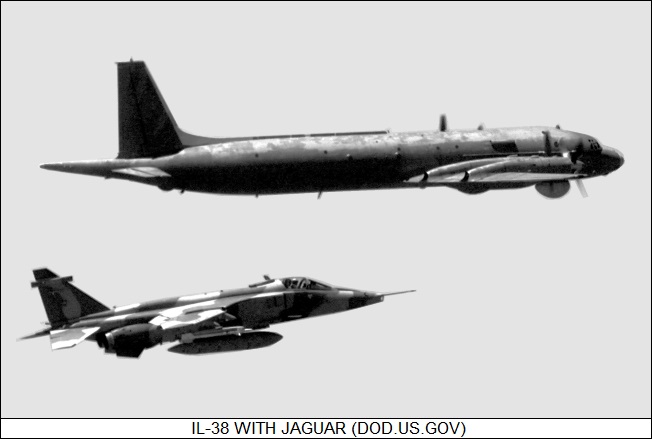
Tests showed that an Il-38 could obtain extended range by cruising on three or even two engines, but that wasn't done as a standard practice. Some Il-38s were configured for maritime search and rescue (MSAR), being fitted with a parachutable rescue pod carried semi-externally in the forward weapons bay. The pod looked like a radome, and Western observers initially believed it to be one. It appears that MSAR-configured Il-38s retained their normal combat capabilities.
Various upgrades were considered or performed on the Il-38:
One Il-38 was modified in the late 1990s as a civil geophysical survey aircraft by fitting it with the appropriate sensor suite. Given that many Il-18s configured for survey missions had been either grounded or converted back to airliner configuration, there was an outstanding need for a replacement.
BACK_TO_TOP* As mentioned above, the Soviet military used the Il-18 as the Il-18T cargolifter -- along with one machine evaluated as the Il-18TD paratroop transport -- and operated a number of Il-18s as staff transports, generally adding improved communications kit so they could be employed as command posts. Some of the staff transports / command posts were fitted with a more powerful TA-6 APU to support mission equipment.
The military also operated Il-18s in more specialized roles. From the mid-1960s, work was performed to adapt the Il-18 to a signals intelligence (SIGINT) configuration, with a prototype of the "Il-20M" performing its initial flight in 1968. The variant entered service in 1970, with 24 built to end of production in 1976. NATO assigned the Il-20M the reporting name "Coot-A".
The Il-20M was a modified Il-18D. Unlike the Il-38, the Il-20M featured no fundamental changes to the airframe, but it sported a litter of antennas -- most prominently a pod under the forward fuselage for a SLAR, plus a smaller fairing on each side of the forward fuselage. The SLAR pod was of the same external configuration as the SLAR pod on the Il-24N ice reconnaissance aircraft, but housed a different radar system; the side fairings had doors for oblique long-range operation (LOROP) cameras to complement the ELINT gear. The right side fairing featured an airscoop to obtain cooling air for the SLAR system.
The nosewheels were fitted with a mudguard to protect the SLAR fairing from damage . The Il-20M had a crew of 13, including five aircrew and eight systems operators. The Il-20M has been kept very secret; its systems have been upgraded in service -- the antenna arrays have been variable in configuration over time -- with one obvious possible update being a modern synthetic aperture radar (SAR) in place of the antiquated SLAR, though details of equipment fits are hard to come by.
The Il-20M has seen extensive service in the post-Soviet era, particularly in Russia's war against Islamic terrorism. Six were assigned to bases in Syria from 2015, working in support of the Syrian government in the course of the civil war. They have on occasion targeted Russian cruise-missile strikes against rebel forces. One was shot down by a Syrian surface-to-air missile (SAM) in 2018, in a case of mistaken identity during an Israeli airstrike. All the Il-20M's 15 crew were killed.
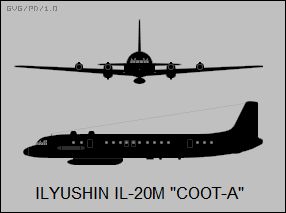
* Two Il-18V machines were converted to a telemetry relay configuration and redesignated "Il-18RT". They featured a prominent thimble fairing on the extreme tail, and were used for obtaining telemetry from trials of rockets and drones. They were "quasi-civil" machines, painted in Aeroflot colors; in a nation where the government effectively ran everything, the distinction between civil and military wasn't as distinct as it is in the USA, and many machines in "Aeroflot" colors spent part or all their time in military service. Some Russian sources joke that the military actually owned all the aircraft -- but the generals were kindly enough to let civil users fly them when the military didn't need them.
Il-18s were also modified to support missile and space booster flights, not merely by providing telemetry relay -- these machines had the tail thimble fairing -- but also optical tracking of the flights, via cameras in a "hump" on the aircraft's back featuring a set of three hatches. The prototype for the series, designated the "Il-18RTL" AKA "IL-18SIP", was a conversion of an Il-18D, performing its initial flight in 1972. Four new-build production machines of slightly different configuration designated "Il-20RT" followed. They were also "quasi-civil" aircraft; they were replaced by the turbofan-powered Il-76MD in the role from 1986. Some or all of the Il-20RT machines were then put into service as transports and trainers, though they retained the dorsal hump fairing.
* One of the most obscure of the military variants of the Il-18 was the "Il-22" airborne command post, based on the Il-18D, with the first Il-22 entering service in 1970. The Il-22 was littered with antennas, most prominently a fairing on the tip of the tailfin, and featured a long ventral fairing running up the belly. Since the Il-22 was to carry a relatively large crew, the rear baggage door on the right side of the aircraft was converted into an escape hatch / chute, while a hydraulically-actuated slipstream deflector panel was installed ahead of the rear passenger door on the left to allow it to be used for escape as well. In addition, a TA-6 APU was installed in the tail.

The conversions were actually performed by the Myasishchev OKB, the Ilyushin OKB being overloaded with other work at the time. When NATO got wind of the Il-22, it was given the reporting name of "Coot-B". A decade later, another batch of airborne command posts was built with some improvements and designated "Il-22M". The most visible distinguishing features were a shorter ventral fairing and deletion of the slipstream deflector on the rear door, since using the door for airborne escape was judged impractical.
About 35 Il-22 and Il-22M machines were built in all. They were flown in "quasi-civil" configuration, painted in Aeroflot colors. Both variants were given limited upgrades in service. Some ended up in the hands of post-Soviet states after the fall of the USSR; a number of Il-22s were ultimately reconverted back to Il-18D configuration, some as VIP / Salon machines.
However, the type still remains in service with Russian forces, an "Il-22PP" conversion, littered with antennas and fairings, having been displayed publicly in 2017. "PP" stands for "postanovshchik pomekh" or "ECM aircraft", with the Il-22PP intended for signals intelligence and stand-off jamming roles. The Il-22M also served in the Ukraine War, one being shot down -- it appears by a long-range surface-to-air missile -- in early 2023.
BACK_TO_TOP* The following list gives the principal variants of the Il-18 family:
* The Il-18 may not have been the most glamorous Soviet aircraft, but it was one of the more successful examples of the class of four-engine turboprop airliners. The British Vickers Viscount was moderately successful in the civil role, but its military usage was minimal; the American Lockheed Electra was a failure as a civil airliner, but saw extensive military use in the form of the P-3 Orion. The Il-18 was successful in both civil and military roles.
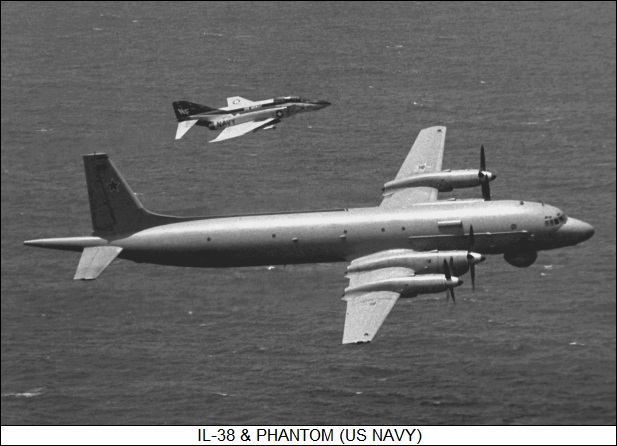
* Trying to document Soviet-Russian aircraft tends to be a pain because traditionally Western documents on them were hopelessly inaccurate, and so there's really only one source for this document:
* Revision history:
v1.0.0 / 01 dec 10 v1.0.1 / 01 jan 11 / Follow-up fix release. v1.0.2 / 01 dec 12 / Review & polish. v1.0.3 / 01 nov 14 / Review & polish. v1.0.4 / 01 oct 16 / Review & polish. v1.0.5 / 01 aug 18 / Review & polish. v1.0.6 / 01 dec 20 / Review & polish. v1.0.7 / 01 nov 22 / Review & polish. v1.0.8 / 01 aug 24 / Review & polish.BACK_TO_TOP
